Synergistic Evolution of PM2.5 and O3 Concentrations: Evidence from Environmental Kuznets Curve Tests in the Yellow River Basin
Abstract
:1. Introduction
- There is an obvious synergistic evolution rule of PM2.5 and O3 concentrations.
- There is a synergistic evolution pattern of decreasing PM2.5 concentration and increasing O3 concentration.
2. Data and Methodology
2.1. Study Area
2.2. Methodology
2.2.1. The Standard Deviational Ellipse (SDE)
2.2.2. Bivariate Kernel Density Estimation (BKD)
2.2.3. Bivariate Spatial Auto-Correlation
2.2.4. Factor Analysis Based on Environmental Kuznets Curves (EKCs)
2.3. Data Processing and Sources
3. Results
3.1. Spatiotemporal Evolution of PM2.5 and O3 Concentrations
3.1.1. Temporal Trends
3.1.2. Spatial Distribution
3.1.3. Centers of Gravity and SDE
3.2. Synergistic Characteristics of the Spatial Correlation between PM2.5 and O3 Concentrations
3.2.1. Synergistic Evolution Characteristic
3.2.2. Spatial Auto-Correlation Characteristic
4. Discussion
4.1. Factor Analysis of Air Pollutant Concentrations
4.2. Heterogeneity Analysis from Different Sub-Watersheds
5. Conclusions and Prospects
5.1. Main Conclusions
5.2. Research Limitations and Future Research Prospects
Author Contributions
Funding
Institutional Review Board Statement
Informed Consent Statement
Data Availability Statement
Conflicts of Interest
References
- Wu, H.; Guo, B.; Guo, T.; Pei, L.; Jing, P.; Wang, Y.; Ma, X.; Bai, H.; Wang, Z.; Xie, T.; et al. A study on identifying synergistic prevention and control regions for PM2.5 and O3 and exploring their spatiotemporal dynamic in China. Environ. Pollut. 2024, 341, 122880. [Google Scholar] [CrossRef] [PubMed]
- Xiao, Q.; Geng, G.; Xue, T.; Liu, S.; Cai, C.; He, K.; Zhang, Q. Tracking PM2.5 and O3 Pollution and the Related Health Burden in China 2013–2020. Environ. Sci. Technol. 2022, 56, 6922–6932. [Google Scholar] [CrossRef] [PubMed]
- Ma, M.; Liu, M.; Song, X.; Liu, M.; Fan, W.; Wang, Y.; Xing, H.; Meng, F.; Lv, Y. Spatiotemporal patterns and quantitative analysis of influencing factors of PM2.5 and O3 pollution in the North China Plain. Atmos. Pollut. Res. 2024, 15, 101950. [Google Scholar] [CrossRef]
- Du, S.; He, C.; Zhang, L.; Zhao, Y.; Chu, L.; Ni, J. Policy implications for synergistic management of PM2.5 and O3 pollution from a pattern-process-sustainability perspective in China. Sci. Total Environ. 2024, 915, 170210. [Google Scholar] [CrossRef] [PubMed]
- Shao, T.; Wang, P.; Yu, W.; Gao, Y.; Zhu, S.; Zhang, Y.; Hu, D.; Zhang, B.; Zhang, H. Drivers of alleviated PM2.5 and O3 concentrations in China from 2013 to 2020. Resour. Conserv. Recycl. 2023, 197, 107110. [Google Scholar] [CrossRef]
- Liu, Y.; Geng, G.; Cheng, J.; Liu, Y.; Xiao, Q.; Liu, L.; Shi, Q.; Tong, D.; He, K.; Zhang, Q. Drivers of increasing Ozone during the two phases of Clean Air Actions in China 2013–2020. Environ. Sci. Technol. 2023, 57, 8954–8964. [Google Scholar] [CrossRef] [PubMed]
- Cheng, C.; Liu, Y.; Han, C.; Fang, Q.; Cui, F.; Li, X. Effects of extreme temperature events on deaths and its interaction with air pollution. Sci. Total Environ. 2024, 915, 170212. [Google Scholar] [CrossRef] [PubMed]
- Peng, M.; Zhang, F.; RMB, Y.; Yang, Z.; Wang, K.; Wang, Y.; Tang, Z.; Zhang, Y. Long-term ozone exposure and all-cause mortality: Cohort evidence in China and global heterogeneity by region. Ecotoxicol. Environ. Saf. 2024, 270, 115843. [Google Scholar] [CrossRef] [PubMed]
- Demoury, C.; Aerts, R.; Berete, F.; Wouter, L.; Pauwels, A.; Vanpoucke, C.; Heyden, J.; Clercq, E. Impact of short-term exposure to air pollution on natural mortality and vulnerable populations: A multi-city case-crossover analysis in Belgium. Environ. Health 2024, 23, 11. [Google Scholar] [CrossRef]
- Liu, Z.; Qi, Z.; Ni, X.; Dong, M.; Ma, M.; Xue, W.; Zhang, Q.; Wang, J. How to apply O3 and PM2.5 collaborative control to practical management in China: A study based on meta-analysis and machine learning. Sci. Total Environ. 2021, 772, 145392. [Google Scholar] [CrossRef]
- Chen, L.; Zhu, J.; Liao, H.; Yang, Y.; Yue, X. Meteorological influences on PM2.5 and O3 trends and associated health burden since China’s clean air actions. Sci. Total Environ. 2020, 744, 140837. [Google Scholar] [CrossRef] [PubMed]
- Gu, Y.; Liu, B.; Meng, H.; Song, S.; Dai, Q.; Shi, L.; Feng, Y.; Hopke, P. Source apportionment of consumed volatile organic compounds in the atmosphere. J. Hazard. Mater. 2023, 459, 132138. [Google Scholar] [CrossRef] [PubMed]
- Liu, J.; Ma, F.; Chen, T.; Jiang, D.; Du, M.; Zhang, X.; Feng, X.; Wang, Q.; Cao, J.; Wang, J. High-time resolution PM2.5 source apportionment assisted by spectrum-based characteristics analysis. Sci. Total Environ. 2024, 912, 169055. [Google Scholar] [CrossRef] [PubMed]
- Wu, J.; Wang, Y.; Liang, J.; Yao, F. Exploring common factors influencing PM2.5 and O3 concentrations in the Pearl River Delta: Tradeoffs and synergies. Environ. Pollut. 2021, 285, 117138. [Google Scholar] [CrossRef] [PubMed]
- Qu, Y.; Wang, T.; Yuan, C.; Wu, H.; Gao, L.; Huang, C.; Li, Y.; Li, M.; Xie, M. The underlying mechanisms of PM2.5 and O3 synergistic pollution in East China: Photochemical and heterogeneous interactions. Sci. Total Environ. 2023, 873, 162434. [Google Scholar] [CrossRef] [PubMed]
- Gauthier-Manuel, H.; Bernard, N.; Boilleaut, M.; Giraudoux, P.; Pujo, L.; Mauny, F. Spatialized temporal dynamics of daily ozone concentrations: Identification of the main spatial differences. Environ. Int. 2023, 173, 107859. [Google Scholar] [CrossRef] [PubMed]
- Qi, G.; Wang, Z.; Wei, L.; Wang, Z. Multidimensional effects of urbanization on PM2.5 concentration in China. Environ. Sci. Pollut. Res. 2022, 29, 77081–77096. [Google Scholar] [CrossRef] [PubMed]
- Duan, W.; Wang, X.; Cheng, S.; Wang, R. Regional division and influencing mechanisms for the collaborative control of PM2.5 and O3 in China: A joint application of multiple mathematic models and data mining technologies. J. Clean. Prod. 2022, 337, 130607. [Google Scholar] [CrossRef]
- Saha, P.; Sengupta, S.; Adams, P.; Robinson, A.; Presto, A. Spatial Correlation of Ultrafine Particle Number and Fine Particle Mass at Urban Scales: Implications for Health Assessment. Environ. Sci. Technol. 2020, 54, 9295–9304. [Google Scholar] [CrossRef]
- Chen, Y.; Li, H.; Karimian, H.; Li, M.; Fan, Q.; Xu, Z. Spatio-temporal variation of ozone pollution risk and its influencing factors in China based on Geodetector and Geospatial models. Chemosphere 2022, 302, 134843. [Google Scholar] [CrossRef]
- Liu, J.; Wang, S.; Zhu, K.; Hu, J.; Li, R.; Song, X. Spatial patterns of the diurnal variations of PM2.5 and their influencing factors across China. Atmos. Environ. 2024, 318, 120215. [Google Scholar] [CrossRef]
- Zhang, Q.; Zheng, Y.; Tong, D.; Shao, M.; Wang, S.; Zhang, Y.; Xu, L.; Wang, J.; He, H.; Hao, J.; et al. Drivers of improved PM2.5 air quality in China from 2013 to 2017. Proc. Natl. Acad. Sci. 2019, 116, 24463–24469. [Google Scholar] [CrossRef] [PubMed]
- Tao, C.; Zhang, Q.; Huo, S.; Ren, Y.; Han, S.; Wang, Q.; Wang, W. PM2.5 pollution modulates the response of ozone formation to VOC emitted from various sources: Insights from machine learning. Sci. Total Environ. 2024, 916, 170009. [Google Scholar] [CrossRef] [PubMed]
- Zhang, Y.; Liu, X.; Zhang, L.; Tang, A.; Goulding, K.; Collett, J. Evolution of secondary inorganic aerosols amidst improving PM2.5 air quality in the North China plain. Environ. Pollut. 2021, 281, 117027. [Google Scholar] [CrossRef] [PubMed]
- Yan, D.; Jin, Z.; Zhou, Y.; Li, M.; Zhang, Z.; Wang, T.; Zhuang, B.; Li, S.; Xie, M. Anthropogenically and meteorologically modulated summertime ozone trends and their health implications since China’s clean air actions. Environ. Pollut. 2024, 343, 123234. [Google Scholar] [CrossRef] [PubMed]
- Liu, J.; Ding, W. Spatial and temporal distribution of PM2.5 and O3 in north China from 2011 to 2020: Patterns and influence mechanisms. Atmos. Pollut. Res. 2023, 14, 101906. [Google Scholar] [CrossRef]
- Meng, Z.; Dabdub, D.; Seinfeld, J. Chemical coupling between atmospheric ozone and particulate matter. Science 1997, 277, 5322. [Google Scholar] [CrossRef]
- Li, K.; Jacob, D.J.; Shen, L.; Lu, X.; De Smedt, I.; Liao, H. Increases in surface ozone pollution in China from 2013 to 2019: Anthropogenic and meteorological influences. Atmos. Chem. Phys. 2020, 20, 11423–11433. [Google Scholar] [CrossRef]
- Benchrif, A.; Wheida, A.; Tahri, M.; Mezouari, H.; Bouziane, M.; El Alami, A.A.; Tachb, K. Air quality during three COVID-19 lockdown phases: AQI, PM2.5 and NO2 assessment in cities with more than 1 million inhabitants. Sustain. Cities Soc. 2021, 5, 103170. [Google Scholar] [CrossRef]
- Wang, Y.; Yao, L.; Xu, Y.; Sun, S.; Li, T. Potential heterogeneity in the relationship between urbanization and air pollution, from the perspective of urban agglomeration. J. Clean. Prod. 2021, 298, 126822. [Google Scholar] [CrossRef]
- Wu, W.; Zhang, M.; Ding, Y. Exploring the effect of economic and environment factors on PM2.5 concentration: A case study of the Beijing-Tianjin-Hebei region. J. Environ. Manag. 2020, 268, 110703. [Google Scholar] [CrossRef]
- Qi, G.; Wei, W.; Wang, Z.; Wang, Z.; Wei, L. The spatial-temporal evolution mechanism of PM2.5 concentration based on China’s climate zoning. J. Environ. Manag. 2023, 325, 116671. [Google Scholar] [CrossRef] [PubMed]
- Yang, K.; Teng, M.; Luo, Y.; Zhou, X.; Zhang, M.; Sun, W.; Li, Q. Human activities and the natural environment have induced changes in the PM2.5 concentrations in Yunnan Province, China, over the past 19 years. Environ. Pollut. 2020, 265, 114878. [Google Scholar] [CrossRef] [PubMed]
- Krall, J.R.; Mulholland, J.A.; Russell, A.G.; Balachandran, S.; Winquist, A.; Tolbert, P.E.; Waller, L.A.; Sarnat, S.E. Associations between source-specific fine particulate matter and emergency department visits for respiratory disease in four U.S. cities. Environ. Health Perspect. 2017, 125, 97–103. [Google Scholar] [CrossRef] [PubMed]
- Dadashazar, H.; Ma, L.; Sorooshian, A. Sources of pollution and interrelationships between aerosol and precipitation chemistry at a central California site. Sci. Total Environ. 2019, 651, 1776–1787. [Google Scholar] [CrossRef] [PubMed]
- Prottay, M.; Sadib, B.; Jobaer, A.; Rafizul, I.; Asif, I. Measuring and modeling PM2.5 zonal distributions, assembling geospatial and meteorological variables in the Khulna metropolitan area. Urban Clim. 2023, 49, 101518. [Google Scholar] [CrossRef]
- Zha, H.; Wang, R.; Feng, X.; An, C.; Qian, J. Spatial characteristics of the PM2.5/PM10 ratio and its indicative significance regarding air pollution in Hebei Province, China. Environ. Monit. Assess. 2021, 193, 486. [Google Scholar] [CrossRef] [PubMed]
- Liu, H.; Cui, W.; Zhang, M. Exploring the causal relationship between urbanization and air pollution: Evidence from China. Sustain. Cities Soc. 2022, 80, 103783. [Google Scholar] [CrossRef]
- Qi, G.; Wang, Z.; Wang, Z.; Wei, L. Has industrial upgrading improved air pollution?—Evidence from China’s digital economy. Sustainability 2022, 14, 8967. [Google Scholar] [CrossRef]
- Zhao, H.; Cheng, Y.; Zheng, R. Impact of the digital economy on PM2.5: Experience from the middle and lower reaches of the Yellow River Basin. Int. J. Environ. Res. Public Health 2022, 19, 17094. [Google Scholar] [CrossRef]
- Tang, Y.; Xie, S.; Huang, L.; Liu, L.; Wei, P.; Zhang, Y.; Meng, C. Spatial estimation of regional PM2.5 concentrations with GWR models using PCA and RBF interpolation optimization. Remote Sens. 2022, 14, 5626. [Google Scholar] [CrossRef]
- Wang, S.; Ren, Y.; Xia, B. PM2.5 and O3 concentration estimation based on interpretable machine learning. Atmos. Pollut. Res. 2023, 14, 101866. [Google Scholar] [CrossRef]
- Zhou, L.; Wu, T.; Pu, L.; Meadows, M.; Jiang, G.; Zhang, J.; Xie, X. Spatially heterogeneous relationships of PM2.5 concentrations with natural and land use factors in the Niger River Watershed, West Africa. J. Clean. Prod. 2023, 394, 136406. [Google Scholar] [CrossRef]
- Tang, Y.; Zhang, X.; Lu, S.; Taghizadeh-Hesary, F. Digital finance and air pollution in China: Evolution characteristics, impact mechanism and regional differences. Resour. Policy 2023, 86, 104073. [Google Scholar] [CrossRef]
- Liu, Y.; Yuan, L. Study on the influencing factors and profitability of horizontal ecological compensation mechanism in Yellow River Basin of China. Environ. Sci. Pollut. Res. 2023, 30, 87353–87367. [Google Scholar] [CrossRef] [PubMed]
- Zhao, H.; Liu, Y.; Gu, T.; Zheng, H.; Wang, Z.; Yang, D. Identifying spatiotemporal heterogeneity of PM2.5 concentrations and the key influencing factors in the middle and lower reaches of the Yellow River. Remote Sens. 2022, 14, 2643. [Google Scholar] [CrossRef]
- Wang, X.; Zhang, Q.; Chang, W.-Y. Does economic agglomeration affect haze pollution? Evidence from China’s Yellow River basin. J. Clean. Prod. 2022, 335, 130271. [Google Scholar] [CrossRef]
- Liu, Y.; Cheng, Y.; Zheng, R.; Zhao, H.; Wang, Y. Impact of the producer services agglomeration on PM2.5: A case study of the Yellow River Basin, China. J. Geogr. Sci. 2023, 33, 2295–2320. [Google Scholar] [CrossRef]
- Zhang, Q.; Zhang, Z.; Shi, P.; Singh, V.; Gu, X. Evaluation of ecological instream flow considering hydrological alterations in the Yellow River Basin, China. Glob. Planet. Change 2018, 160, 61–74. [Google Scholar] [CrossRef]
- Yuan, X.; Sheng, X.; Chen, L.; Tang, Y.; Li, Y.; Jia, Y.; Qu, D.; Wang, Q.; Ma, Q.; Zuo, J. Carbon footprint and embodied carbon transfer at the provincial level of the Yellow River Basin. Sci. Total Environ. 2022, 803, 149993. [Google Scholar] [CrossRef]
- Wang, D.; Liu, Y.; Cheng, Y. Effects and spatial spillover of manufacturing agglomeration on carbon emissions in the Yellow River Basin, China. Sustainability 2023, 15, 9386. [Google Scholar] [CrossRef]
- Zhang, S.; Lv, Y.; Zhang, B. Spatio-temporal evolution and influencing factors of green development in the Yellow River Basin of China. Sustainability 2022, 14, 12407. [Google Scholar] [CrossRef]
- Chen, Y.; Liu, S.; Ma, W.; Zhou, Q. Assessment of the carrying capacity and suitability of spatial resources and the environment and diagnosis of obstacle factors in the Yellow River Basin. Int. J. Environ. Res. Public Health 2023, 20, 3496. [Google Scholar] [CrossRef]
- Lefever, D. Measuring geographic concentration by means of the standard deviational ellipse. Am. J. Sociol. 1926, 1, 88–94. [Google Scholar] [CrossRef]
- Emanuel, P. On estimation of a probability density function and mode. Ann. Math. Stat. 1962, 33, 1065–1076. [Google Scholar] [CrossRef]
- Qi, G.; Che, J.; Wang, Z. Differential effects of urbanization on air pollution: Evidences from six air pollutants in mainland China. Ecol. Indic. 2023, 146, 109924. [Google Scholar] [CrossRef]
- Anselin, L. Local indicators of spatial association: LISA. Geogr. Anal. 1995, 27, 93–115. [Google Scholar] [CrossRef]
- Grossman, G.; Krueger, A. Economic growth and the environment. Q. J. Econ. 1995, 110, 353–377. [Google Scholar] [CrossRef]
- Hering, L.; Poncet, S. Environmental policy and exports: Evidence from Chinese cities. J. Environ. Econ. Manag. 2014, 68, 296–318. [Google Scholar] [CrossRef]
- Wang, Y.; Komonpipat, S. Revisiting the environmental Kuznets curve of PM2.5 concentration: Evidence from prefecture-level and above cities of China. Environ. Sci. Pollut. Res. 2020, 27, 9336–9348. [Google Scholar] [CrossRef]
- Liu, C.; Yang, D.; Sun, J.; Cheng, Y. The impact of environmental regulations on pollution and carbon reduction in the Yellow River Basin, China. Int. J. Environ. Res. Public Health 2023, 20, 1709. [Google Scholar] [CrossRef] [PubMed]
- Ding, W.; Liu, J. Nonlinear and spatial spillover effects of urbanization on air pollution and ecological resilience in the Yellow River Basin. Environ. Sci. Pollut. Res. 2023, 30, 43229–43244. [Google Scholar] [CrossRef] [PubMed]
- Zhao, H.; Chen, K.; Liu, Z.; Zhang, Y.; Shao, T.; Zhang, H. Coordinated control of PM2.5 and O3 is urgently needed in China after implementation of the “Air pollution prevention and control action plan”. Chemosphere 2021, 270, 129441. [Google Scholar] [CrossRef] [PubMed]
- Markandya, A.; Sampedro, J.; Smith, S.J.; Van Dingenen, R.; Pizarro-Irizar, C.; Arto, I.; Gonzalez-Eguino, M. Health co-benefits from air pollution and mitigation costs of the Paris Agreement: A modelling study. Lancet Planet. Health 2018, 2, e126–e133. [Google Scholar] [CrossRef] [PubMed]
- Cheng, J.; Tong, D.; Zhang, Q.; Liu, Y.; Lei, Y.; Yan, G.; Yan, L.; Yu, S.; Cui, R.Y.; Clarke, L.; et al. Pathways of China’s PM2.5 air quality 2015–2060 in the context of carbon neutrality. Natl. Sci. Rev. 2021, 8, nwab078. [Google Scholar] [CrossRef] [PubMed]
- Cheng, J.; Tong, D.; Liu, Y.; Geng, G.; Davis, S.J.; He, K.; Zhang, Q. A synergistic approach to air pollution control and carbon neutrality in China can avoid millions of premature deaths annually by 2060. One Earth 2023, 6, 978–989. [Google Scholar] [CrossRef]
- Li, N.; Chen, W.; Rafaj, P.; Kiesewetter, G.; Schoepp, W.; Wang, H.; Zhang, H.; Krey, V.; Riahi, K. Air Quality Improvement Co-benefits of Low-Carbon Pathways toward Well Below the 2 °C Climate Target in China. Environ. Sci. Technol. 2019, 53, 5576–5584. [Google Scholar] [CrossRef]
- Shi, X.; Zheng, Y.; Lei, Y.; Xue, W.; Yan, G.; Liu, X.; Cai, B.; Tong, D.; Wang, J. Air quality benefits of achieving carbon neutrality in China. Sci. Total Environ. 2021, 795, 148784. [Google Scholar] [CrossRef]
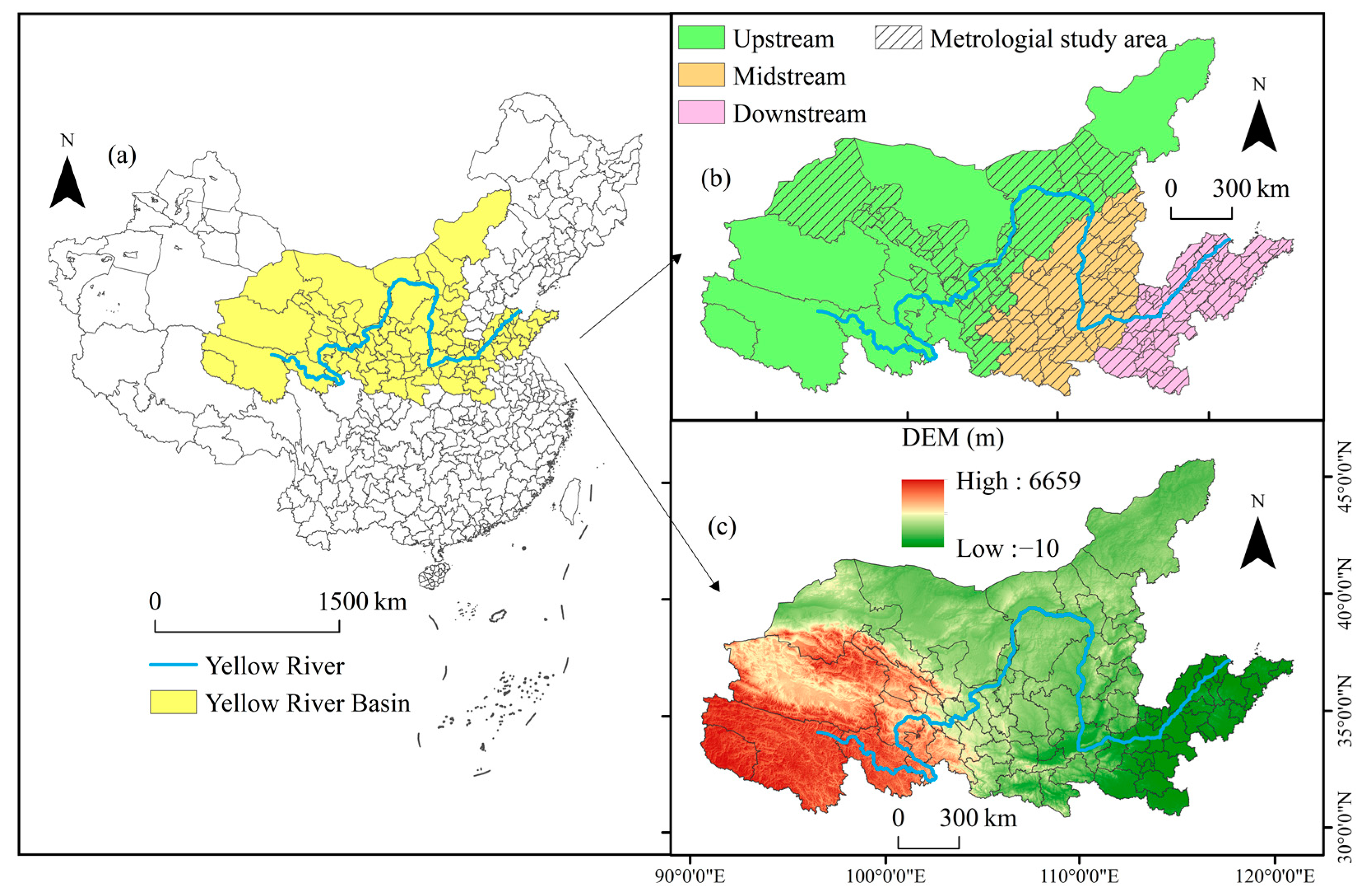


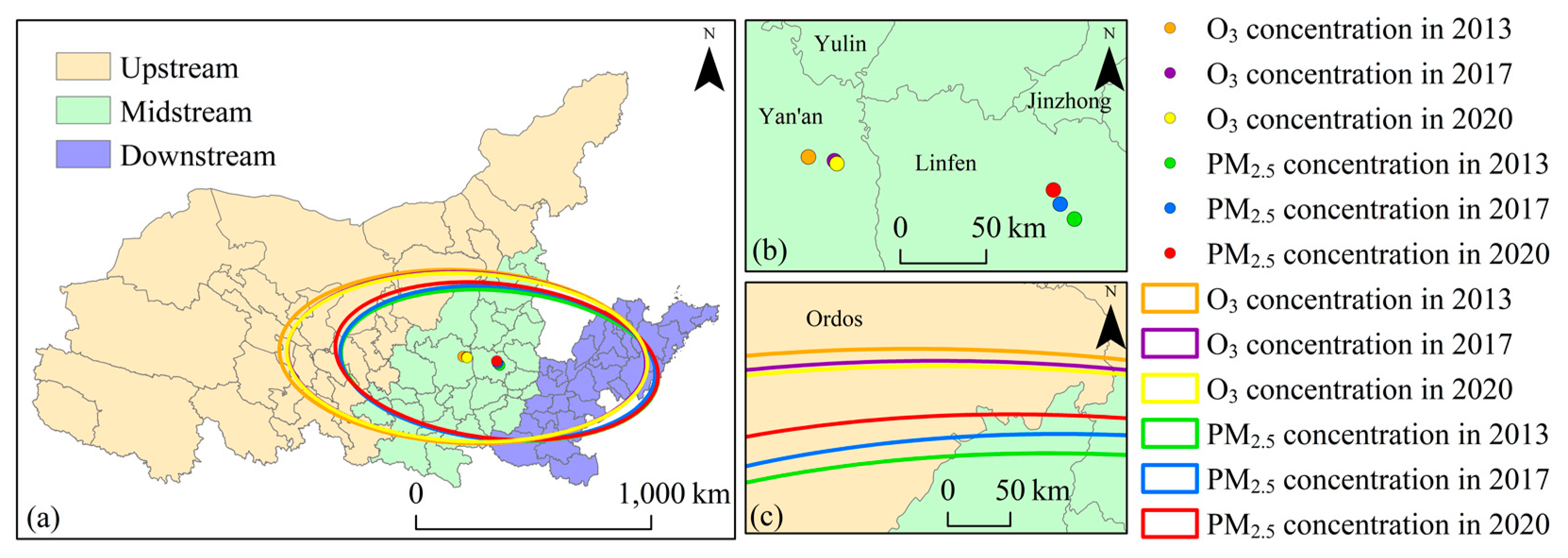

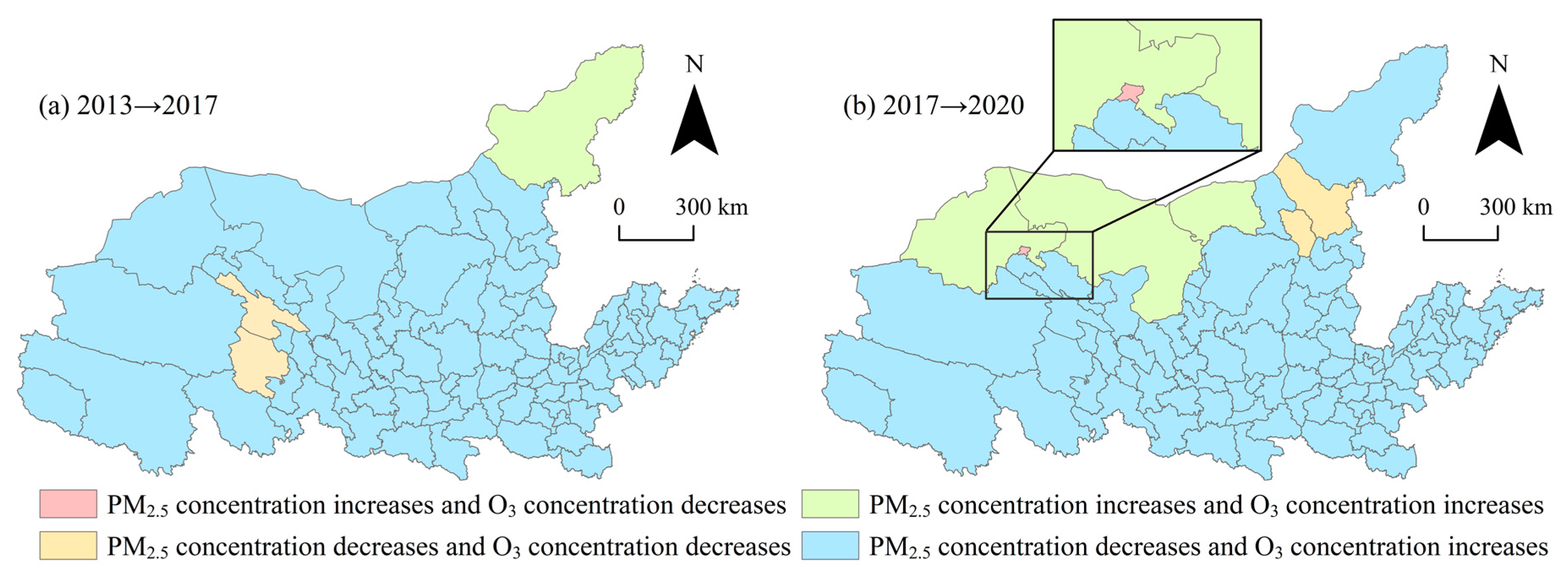
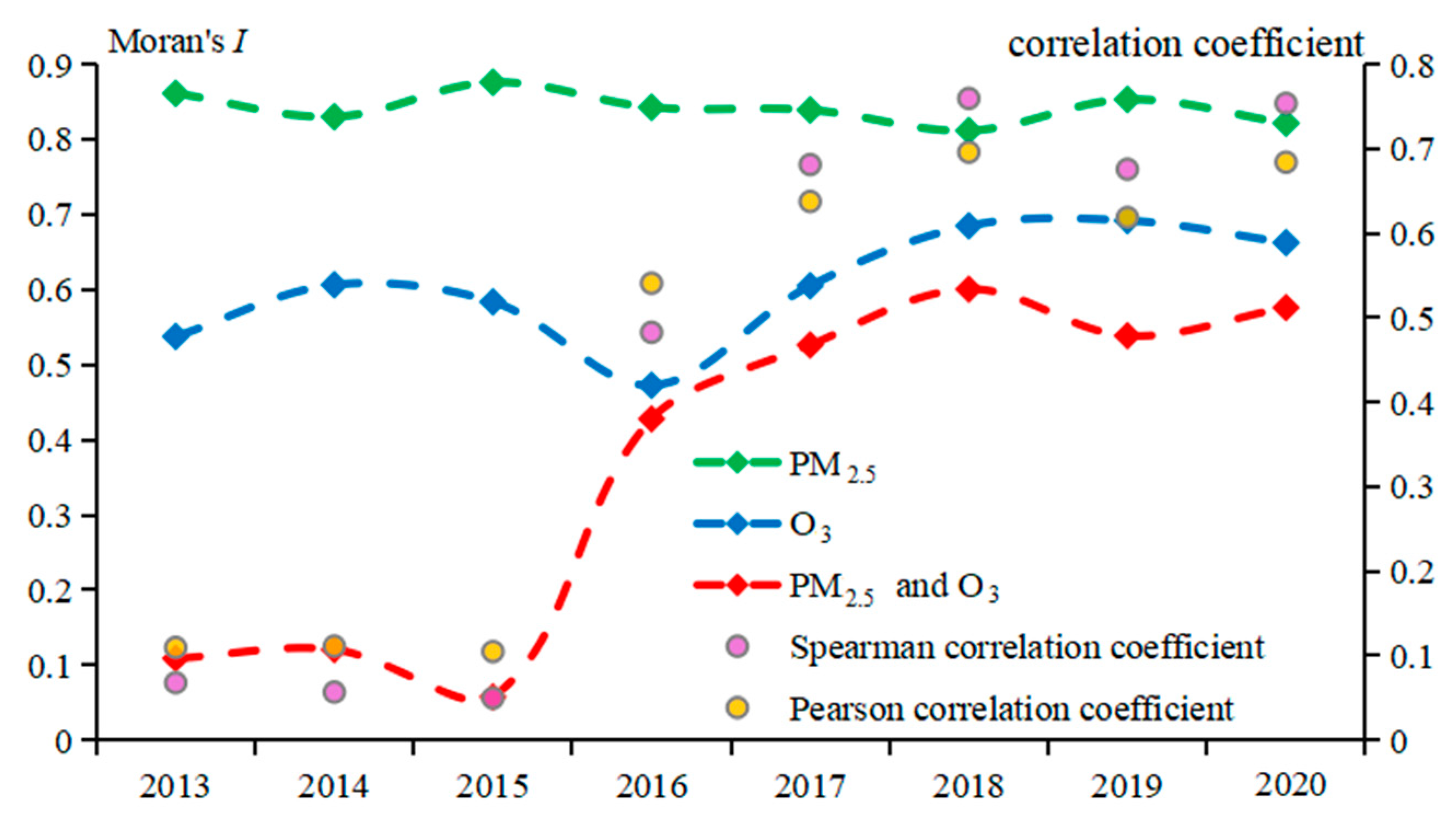


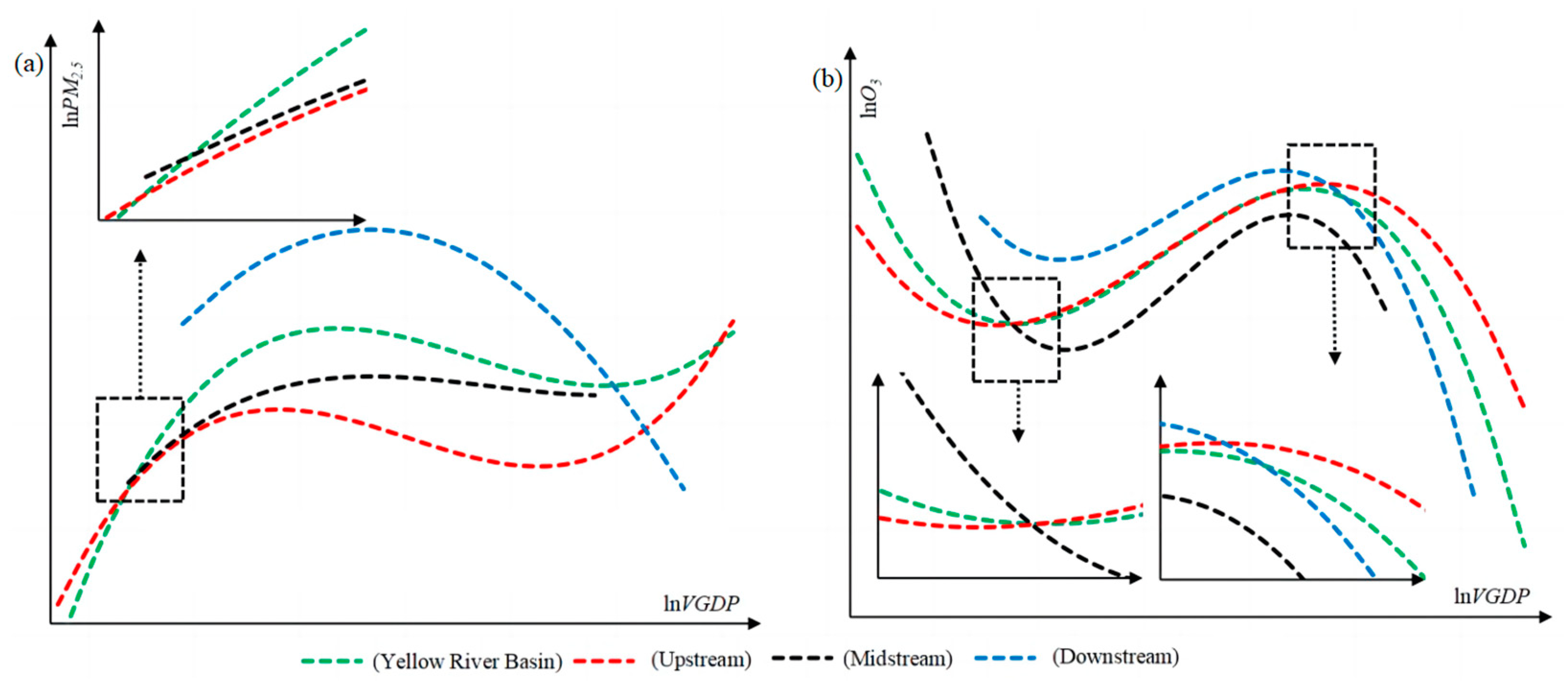

| Parameter α1 | Parameter α2 | Parameter α3 | Shape |
|---|---|---|---|
| α1 > 0 | α2 = 0 | α3 = 0 | Linear increase |
| α1 < 0 | α2 = 0 | α3 = 0 | Linear decrease |
| α1 > 0 | α2 < 0 | α3 = 0 | Inverted U |
| α1 < 0 | α2 > 0 | α3 = 0 | U |
| α1 > 0 | α2 < 0 | α3 > 0 | N |
| α1 < 0 | α2 > 0 | α3 < 0 | Inverted N |
| Code | Data Definition | Source |
|---|---|---|
| PM2.5 | Average annual PM2.5 concentration | Atmospheric Composition Analysis Group (ACAG) 1 |
| O3 | Average annual O3 concentration | China High Air Pollutants (CHAP) dataset 2 |
| VGDP | Per capita GDP | Provincial Statistical Yearbook (2014–2021) in the YRB |
| PU | Population urbanization rate | |
| PD | Population density | |
| Ind | the index of industrial sophistication | |
| NDVI | Normalized difference vegetation index | NASA 3 |
| PRCP | Average annual precipitation | European Centre for Medium-Range Weather Forecasts (ECMWF) 4 |
| VC | Ventilation coefficients |
| Type | Year | Semimajor Axis (km) | Semiminor Axis (km) | Shape Ratio | Rotation (°) | Area (km2) | Barycentric Coordinates |
|---|---|---|---|---|---|---|---|
| PM2.5 concentration | 2013 | 676.57 | 315.71 | 0.467 | 95.47 | 670,968.82 | 111°43′27″ E 36°10′16″ N |
| 2017 | 671.40 | 323.76 | 0.482 | 94.83 | 682,824.43 | 111°38′27″ E 36°15′16″ N | |
| 2020 | 689.52 | 327.77 | 0.475 | 96.54 | 709,933.20 | 111°35′37″ E 36°19′42″ N | |
| O3 concentration | 2013 | 782.18 | 366.69 | 0.469 | 92.63 | 900,964.22 | 109°59′58″ E 36°33′30″ N |
| 2017 | 762.32 | 359.40 | 0.471 | 92.58 | 860,645.72 | 110°10′18″ E 36°32′5″ N | |
| 2020 | 766.37 | 356.98 | 0.466 | 92.49 | 859,376.96 | 110°11′13″ E 36°31′4″ N |
| Code | Obs | Mean | Std | Maximum | Minimum | HT Test | |
|---|---|---|---|---|---|---|---|
| Statistic | p | ||||||
| lnPM2.5 | 624 | 3.77 | 0.33 | 4.52 | 2.97 | 0.09 | 0.00 |
| lnO3 | 624 | 4.57 | 0.13 | 4.81 | 4.18 | 0.88 | 0.00 |
| lnVGDP | 624 | 10.77 | 0.56 | 12.46 | 9.04 | 0.27 | 0.00 |
| ln2VGDP | 624 | 116.28 | 12.03 | 155.16 | 81.66 | 0.26 | 0.00 |
| ln3VGDP | 624 | 1258.94 | 195.29 | 1932.74 | 737.98 | 0.25 | 0.00 |
| lnPU | 624 | 3.99 | 0.25 | 4.56 | 3.03 | 0.21 | 0.00 |
| lnPD | 624 | 5.57 | 1.08 | 7.44 | 1.77 | 0.61 | 0.06 |
| Ind | 624 | 1.08 | 0.59 | 5.25 | 0.26 | 0.32 | 0.00 |
| lnPRCP | 624 | 6.43 | 0.31 | 7.22 | 5.29 | −0.05 | 0.00 |
| NDVI | 624 | 0.64 | 0.20 | 0.89 | 0.07 | −0.14 | 0.00 |
| VC | 624 | 7.38 | 0.53 | 8.81 | 5.31 | −0.05 | 0.00 |
| Variable | PM2.5 Concentration | O3 Concentration | ||
|---|---|---|---|---|
| Model I (RE) | Model II (FE) | Model III (RE) | Model IV (FE) | |
| lnVGDP | 21.28 *** | 20.48 *** | −19.70 *** | −31.87 *** |
| ln2VGDP | −1.99 *** | −1.91 *** | 1.89 *** | 2.96 *** |
| ln3VGDP | 0.06 *** | 0.06 *** | −0.06 *** | −0.09 *** |
| lnPU | −0.36 *** | −0.53 *** | 0.05 | 0.36 *** |
| lnPD | 0.18 *** | −0.05 | 0.01 | 0.10 *** |
| Ind | −0.12 *** | −0.08 *** | 0.10 *** | 0.09 *** |
| NDVI | 0.45 *** | 0.53 *** | −0.08 | 0.00 |
| lnPRCP | −0.09 ** | −0.02 | −0.04 | −0.13 *** |
| VC | −0.11 *** | −0.11 *** | 0.07 *** | 0.07 *** |
| cons | −69.85 *** | −65.28 *** | 71.80 *** | 115.95 *** |
| R2 | 0.442 | 0.652 | 0.135 | 0.638 |
| F | — | 111.55 | — | 105.16 |
| N | 624 | 624 | 624 | 624 |
| Variable | PM2.5 Concentration | O3 Concentration | ||||
|---|---|---|---|---|---|---|
| Model V Upstream | Model VI Midstream | Model VII Downstream | Model VIII Upstream | Model IX Midstream | Model X Downstream | |
| lnVGDP | 13.55 ** | 37.02 *** | 1.70 *** | −23.61 *** | −69.04 *** | −17.68 ** |
| ln2VGDP | −1.32 ** | −3.49 *** | −0.08 *** | 2.25 *** | 6.46 *** | 1.59 ** |
| ln3VGDP | 0.04 ** | 0.11 *** | — | −0.07 *** | −0.20 *** | −0.05 ** |
| lnPU | −0.11 | −0.53 *** | −1.17 *** | 0.13 * | 0.25 *** | 0.97 *** |
| lnPD | −0.02 | 0.17 * | 0.00 | 0.16 *** | 0.20 ** | 0.01 |
| Ind | −0.09 *** | −0.04 ** | −0.12 *** | 0.05 *** | 0.13 *** | 0.11 *** |
| NDVI | 0.40 *** | 0.50 *** | 0.68 *** | 0.01 | −0.10 | 0.06 |
| lnPRCP | −0.24 *** | 0.04 | −0.02 | 0.06 | −0.23 *** | −0.08 ** |
| VC | −0.06 ** | −0.12 *** | −0.11 *** | 0.07 *** | 0.11 *** | −0.00 |
| cons | −39.59 * | −124.74 ** | 0.70 | 83.93 *** | 247.42 *** | 66.35 ** |
| R2 | 0.573 | 0.661 | 0.810 | 0.547 | 0.704 | 0.796 |
| F | 20.58 | 39.07 | 107.89 | 18.49 | 47.44 | 87.09 |
| N | 168 | 216 | 240 | 168 | 216 | 240 |
Disclaimer/Publisher’s Note: The statements, opinions and data contained in all publications are solely those of the individual author(s) and contributor(s) and not of MDPI and/or the editor(s). MDPI and/or the editor(s) disclaim responsibility for any injury to people or property resulting from any ideas, methods, instructions or products referred to in the content. |
© 2024 by the authors. Licensee MDPI, Basel, Switzerland. This article is an open access article distributed under the terms and conditions of the Creative Commons Attribution (CC BY) license (https://creativecommons.org/licenses/by/4.0/).
Share and Cite
Qi, G.; Miao, Y.; Xie, F.; Teng, C.; Wang, C.; Wang, Z. Synergistic Evolution of PM2.5 and O3 Concentrations: Evidence from Environmental Kuznets Curve Tests in the Yellow River Basin. Sustainability 2024, 16, 4744. https://doi.org/10.3390/su16114744
Qi G, Miao Y, Xie F, Teng C, Wang C, Wang Z. Synergistic Evolution of PM2.5 and O3 Concentrations: Evidence from Environmental Kuznets Curve Tests in the Yellow River Basin. Sustainability. 2024; 16(11):4744. https://doi.org/10.3390/su16114744
Chicago/Turabian StyleQi, Guangzhi, Yi Miao, Fucong Xie, Chao Teng, Chengxin Wang, and Zhibao Wang. 2024. "Synergistic Evolution of PM2.5 and O3 Concentrations: Evidence from Environmental Kuznets Curve Tests in the Yellow River Basin" Sustainability 16, no. 11: 4744. https://doi.org/10.3390/su16114744







